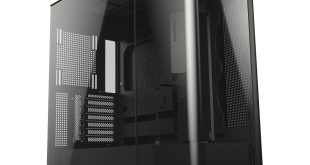As was the case with all of its predecessors, the Phantom 820 is a striking design. NZXT has done an excellent job in balancing the curves and grooves to keep them at a level where they are attractive and eye-catching, not eyesores.
An appropriately sized transparent window is located on the Phantom 820's main side panel. The window's location allows users to view their main hardware such as motherboard, CPU cooler, memory and graphics card, but hides the less attractive cables which exit a power supply and motherboard SATA ports.
NZXT supplies a 200mm low-speed intake fan in the side panel mounting location, behind a dust filter.
The Phantom 820 features a ‘separation' line passing down the entirety of its front side. This helps to create an attractive head-on appearance by reflecting light from the angled areas either side of the line.
A large mesh panel provides an area for air to easily flow through, allowing the front-mounted 200mm intake fan to do its job with minimal interferences.
Opening the magnetised door reveals access to four 5.25″ bay areas and the ‘secondary' user area of the front panel. This ‘secondary' area features a button which controls the rear IO light, another toggle button which controls the main LED system's activation, a knob which changes the main LED system's colour, and a SD card reader powered by an internal USB 2.0 header.
NZXT seems to have increased the bearing friction of the door's hinge; this is a good decision which prevents it moving back and forth under its own weight.
Up to three thumb screws can be used to secure each side panel door, or, if preferred, users can take advantage of the Phantom 820's quick-release mechanism which requires only the middle thumb screw to be used.
Four watercooling grommets are provided for users that prefer external radiators.
Towards the rear of the roof is a mesh area which allows air to exit the Phantom 820, thanks to the supplied 200mm NZXT exhaust fan. This mesh extends as far as the roof's IO area, meaning that objects such as screws will not fall into the chassis.
A unique and very likeable ‘dashed' pattern is used on the middle area of the Phantom 820's roof. We have to compliment NZXT for its ability to take a simple design method and successfully forge it into an eye-catching and attractive feature.
A pair of USB 3.0 ports is backed by four USB 2.0 ports, giving even the most on-the-move of users plenty of easy-to-access connections. These six ports can be covered by the supplied rubber sheet, allowing them to be concealed by users that dislike the appearance of front panel ports.
Power and reset buttons are located adjacent to the fan control system, 3.5mm jacks and LED strip. Oddly enough, the Phantom 820's power button doesn't feature any type of sticker or symbol indicating its function.
The basic fan control system consists of + and – buttons which can manipulate speed, and a selector button that changes which fan is selected. This system is basic and slightly awkward to get used to, at first. It also relies on four brightness-varying LEDs (which are located adjacent to printed letters that indicate the specific fan channel) as speed level indicators. Viewing the five-step brightness level doesn't make identifying or setting a specific fan speed a quick and easy task.
The bottom of the Phantom 820 is split into two separate sections; a pedestal base to the front, and a more standard one to the rear. The unique design resembles a military Half-track vehicle, in this editor's opinion. Rubber tips dampen the effect of noise-causing vibrations.
NZXT has left an adequate amount of clearance between the bottom area of the Phantom 820's internals, and the surface that the case will be sat upon. This clearance allows air to access the power supply and bottom-mounted intake fans, if required.
An easy-to-remove dust filter is located at both the back and front sides of the Phantom 820's bottom panel. One protects the power supply's fan, while the other prevents dust entry via the bottom fan mounting location. They use an easy access system which requires them to be pushed in before popping out of their secured state.
 KitGuru KitGuru.net – Tech News | Hardware News | Hardware Reviews | IOS | Mobile | Gaming | Graphics Cards
KitGuru KitGuru.net – Tech News | Hardware News | Hardware Reviews | IOS | Mobile | Gaming | Graphics Cards













